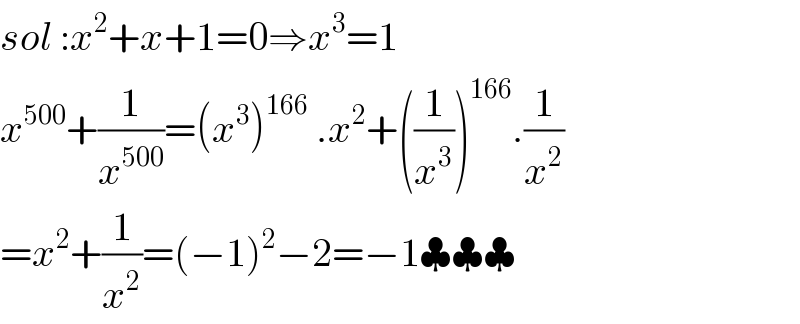Question Number 108480 by I want to learn more last updated on 17/Aug/20

Answered by Rasheed.Sindhi last updated on 17/Aug/20

$$\:\:\:\:\:\:{x}^{\mathrm{2}} +{x}+\mathrm{1}=\mathrm{0}\:\:,\:\:{x}^{\mathrm{500}} +\frac{\mathrm{1}}{{x}^{\mathrm{500}} }=? \\ $$$${x}^{\mathrm{2}} +{x}+\mathrm{1}=\mathrm{0}\Rightarrow{x}\left({x}+\frac{\mathrm{1}}{{x}}+\mathrm{1}\right)=\mathrm{0} \\ $$$${x}\neq\mathrm{0}\:\Rightarrow\:{x}+\frac{\mathrm{1}}{{x}}=−\mathrm{1} \\ $$$$\:\left(\:{x}+\frac{\mathrm{1}}{{x}}\right)^{\mathrm{2}} =\left(−\mathrm{1}\right)^{\mathrm{2}} \:\:\: \\ $$$$\:{x}^{\mathrm{2}} +\frac{\mathrm{1}}{{x}^{\mathrm{2}} }=\mathrm{1}−\mathrm{2}=−\mathrm{1}\:…………..\left({i}\right) \\ $$$$\left({x}+\frac{\mathrm{1}}{{x}}\right)^{\mathrm{3}} =\left(−\mathrm{1}\right)^{\mathrm{3}} \\ $$$$\:{x}^{\mathrm{3}} +\frac{\mathrm{1}}{{x}^{\mathrm{3}} }+\mathrm{3}\left({x}+\frac{\mathrm{1}}{{x}}\right)=−\mathrm{1} \\ $$$$\:\:{x}^{\mathrm{3}} +\frac{\mathrm{1}}{{x}^{\mathrm{3}} }+\mathrm{3}\left(−\mathrm{1}\right)=−\mathrm{1} \\ $$$$\:{x}^{\mathrm{3}} +\frac{\mathrm{1}}{{x}^{\mathrm{3}} }=\mathrm{2}……………….\left({ii}\right) \\ $$$$\left({i}\right)×\left({ii}\right) \\ $$$${x}^{\mathrm{5}} +\frac{\mathrm{1}}{{x}^{\mathrm{5}} }+{x}+\frac{\mathrm{1}}{{x}}=−\mathrm{2} \\ $$$${x}^{\mathrm{5}} +\frac{\mathrm{1}}{{x}^{\mathrm{5}} }+\left(−\mathrm{1}\right)=−\mathrm{2} \\ $$$${x}^{\mathrm{5}} +\frac{\mathrm{1}}{{x}^{\mathrm{5}} }=−\mathrm{1}……………….\left({iii}\right) \\ $$$$\left({x}^{\mathrm{5}} +\frac{\mathrm{1}}{{x}^{\mathrm{5}} }\right)^{\mathrm{2}} =\left(−\mathrm{1}\right)^{\mathrm{2}} \\ $$$${x}^{\mathrm{10}} +\frac{\mathrm{1}}{{x}^{\mathrm{10}} }=−\mathrm{1} \\ $$$${x}^{{n}} +\frac{\mathrm{1}}{{x}^{{n}} }=−\mathrm{1} \\ $$$$\Rightarrow\left({x}^{{n}} +\frac{\mathrm{1}}{{x}^{{n}} }\right)^{\mathrm{2}} =\left(−\mathrm{1}\right)^{\mathrm{2}} \\ $$$$\Rightarrow{x}^{\mathrm{2}{n}} +\frac{\mathrm{1}}{{x}^{\mathrm{2}{n}} }=\mathrm{1}−\mathrm{2}=−\mathrm{1} \\ $$$$\overline {\:\:\:\:\:\langle{x}^{{n}} +\frac{\mathrm{1}}{{x}^{{n}} }=−\mathrm{1}\Rightarrow{x}^{\mathrm{2}{n}} +\frac{\mathrm{1}}{{x}^{\mathrm{2}{n}} }=−\mathrm{1}\rangle\:\:\:\:\:} \\ $$$${Similarly} \\ $$$$\overline {\:\:\:\:\:\:\langle\:\:{x}^{{n}} +\frac{\mathrm{1}}{{x}^{{n}} }=\mathrm{2}\Rightarrow{x}^{\mathrm{3}{n}} +\frac{\mathrm{1}}{{x}^{\mathrm{3}{n}} }=\mathrm{2}\:\:\rangle\:\:\:\:\:} \\ $$$$ \\ $$$$…. \\ $$$$…… \\ $$
Commented by I want to learn more last updated on 17/Aug/20

$$\mathrm{Thanks}\:\mathrm{sir},\:\:\mathrm{i}\:\mathrm{appreciate} \\ $$
Commented by udaythool last updated on 17/Aug/20

$$\mathrm{supper} \\ $$
Answered by 1549442205PVT last updated on 17/Aug/20

$$\mathrm{From}\:\mathrm{the}\:\mathrm{hypothesis}\:\mathrm{we}\:\mathrm{get} \\ $$$$\mathrm{x}^{\mathrm{2}} +\mathrm{x}+\mathrm{1}=\mathrm{0}\:\Delta=\mathrm{1}−\mathrm{4}=−\mathrm{3}=\mathrm{3i}^{\mathrm{2}} \\ $$$$\Rightarrow\mathrm{x}=\frac{−\mathrm{1}\pm\mathrm{i}\sqrt{\mathrm{3}}}{\mathrm{2}}=\mathrm{cos}\frac{\mathrm{2}\pi}{\mathrm{3}}\pm\mathrm{isin}\frac{\mathrm{2}\pi}{\mathrm{3}} \\ $$$$\Rightarrow\mathrm{x}^{\mathrm{500}} =\left(\mathrm{cos}\frac{\mathrm{2}\pi}{\mathrm{3}}\pm\mathrm{isin}\frac{\mathrm{2}\pi}{\mathrm{3}}\right)^{\mathrm{500}} \\ $$$$=\mathrm{cos}\frac{\mathrm{1000}\pi}{\mathrm{3}}\pm\mathrm{sin}\frac{\mathrm{1000}\pi}{\mathrm{3}}=\mathrm{cos}\left(\mathrm{333}\pi+\frac{\pi}{\mathrm{3}}\right)\pm\mathrm{isin}\left(\mathrm{333}\pi+\frac{\pi}{\mathrm{3}}\right) \\ $$$$=−\mathrm{cos}\frac{\pi}{\mathrm{3}}\mp\mathrm{isin}\frac{\pi}{\mathrm{3}}=−\frac{\mathrm{1}}{\mathrm{2}}\mp\mathrm{i}\frac{\sqrt{\mathrm{3}}}{\mathrm{2}} \\ $$$$=\frac{−\mathrm{1}\mp\mathrm{i}\sqrt{\mathrm{3}}}{\mathrm{2}}\left(\mathrm{1}\right) \\ $$$$\Rightarrow\frac{\mathrm{1}}{\mathrm{x}^{\mathrm{500}} }=\frac{\mathrm{2}}{−\mathrm{1}\mp\mathrm{i}\sqrt{\mathrm{3}}}=\frac{\mathrm{2}\left(−\mathrm{1}\pm\mathrm{i}\sqrt{\mathrm{3}}\right)}{\left(−\mathrm{1}\right)^{\mathrm{2}} −\left(\mathrm{i}\sqrt{\mathrm{3}}\right)^{\mathrm{2}} }=\frac{\mathrm{2}\left(−\mathrm{1}\pm\mathrm{i}\sqrt{\mathrm{3}}\right)}{\mathrm{1}−\mathrm{3i}^{\mathrm{2}} } \\ $$$$=\frac{\mathrm{2}\left(−\mathrm{1}\pm\mathrm{i}\sqrt{\mathrm{3}}\right)}{\mathrm{4}}=\frac{−\mathrm{1}\pm\mathrm{i}\sqrt{\mathrm{3}}}{\mathrm{2}}\left(\mathrm{2}\right) \\ $$$$\mathrm{Adding}\:\mathrm{up}\:\mathrm{two}\:\mathrm{the}\:\mathrm{eqialities}\:\left(\mathrm{1}\right)\:\left(\mathrm{2}\right) \\ $$$$\mathrm{we}\:\mathrm{get}\:\mathrm{x}^{\mathrm{500}} +\frac{\mathrm{1}}{\mathrm{x}^{\mathrm{500}} }=\frac{−\mathrm{1}\mp\mathrm{i}\sqrt{\mathrm{3}}+−\mathrm{1}\pm\mathrm{i}\sqrt{\mathrm{3}}}{\mathrm{2}}=−\mathrm{1} \\ $$$$\mathrm{Thus},\boldsymbol{\mathrm{x}}^{\mathrm{500}} +\frac{\mathrm{1}}{\boldsymbol{\mathrm{x}}^{\mathrm{500}} }=\frac{−\mathrm{2}}{\mathrm{2}}=−\mathrm{1}. \\ $$
Commented by I want to learn more last updated on 17/Aug/20

$$\mathrm{Thanks}\:\mathrm{sir} \\ $$
Answered by Dwaipayan Shikari last updated on 17/Aug/20

$${x}^{\mathrm{2}} +{x}+\mathrm{1}=\mathrm{0} \\ $$$${x}={e}^{\frac{\mathrm{2}{i}\pi}{\mathrm{3}}} \:{or}\:{e}^{−\frac{\mathrm{2}{i}\pi}{\mathrm{3}}} \\ $$$${x}^{\mathrm{500}} ={e}^{\frac{\mathrm{1000}{i}\pi}{\mathrm{3}}} ={e}^{−\frac{\mathrm{2}\pi{i}}{\mathrm{3}}} =−\left(\frac{\mathrm{1}}{\mathrm{2}}+\frac{\sqrt{\mathrm{3}}}{\mathrm{2}}{i}\right) \\ $$$$\frac{\mathrm{1}}{{x}^{\mathrm{500}} }={e}^{\frac{−\mathrm{1000}\pi{i}}{\mathrm{3}}} ={e}^{\frac{\mathrm{2}{i}\pi}{\mathrm{3}}} =−\frac{\mathrm{1}}{\mathrm{2}}+\frac{\sqrt{\mathrm{3}}}{\mathrm{2}}{i} \\ $$$${x}^{\mathrm{500}} +\frac{\mathrm{1}}{{x}^{\mathrm{500}} }=−\mathrm{1} \\ $$$${Or} \\ $$$${x}^{\mathrm{500}} ={e}^{−\frac{\mathrm{1000}{i}\pi}{\mathrm{3}}} \\ $$$$\frac{\mathrm{1}}{{x}^{\mathrm{500}} }={e}^{\frac{\mathrm{1000}{i}\pi}{\mathrm{3}}} \\ $$$${x}^{\mathrm{500}} +\frac{\mathrm{1}}{{x}^{\mathrm{500}} }=−\mathrm{1} \\ $$$$ \\ $$
Commented by udaythool last updated on 17/Aug/20

$$\mathrm{excellent} \\ $$
Commented by I want to learn more last updated on 17/Aug/20

$$\mathrm{Thanks}\:\mathrm{sir} \\ $$
Answered by mnjuly1970 last updated on 17/Aug/20

$${sol}\::{x}^{\mathrm{2}} +{x}+\mathrm{1}=\mathrm{0}\Rightarrow{x}^{\mathrm{3}} =\mathrm{1} \\ $$$${x}^{\mathrm{500}} +\frac{\mathrm{1}}{{x}^{\mathrm{500}} }=\left({x}^{\mathrm{3}} \right)^{\mathrm{166}} \:.{x}^{\mathrm{2}} +\left(\frac{\mathrm{1}}{{x}^{\mathrm{3}} }\right)^{\mathrm{166}} .\frac{\mathrm{1}}{{x}^{\mathrm{2}} } \\ $$$$={x}^{\mathrm{2}} +\frac{\mathrm{1}}{{x}^{\mathrm{2}} }=\left(−\mathrm{1}\right)^{\mathrm{2}} −\mathrm{2}=−\mathrm{1}\clubsuit\clubsuit\clubsuit \\ $$
Commented by I want to learn more last updated on 17/Aug/20

$$\mathrm{Thanks}\:\mathrm{sir} \\ $$
Answered by Rasheed.Sindhi last updated on 17/Aug/20

$${x}^{\mathrm{2}} +{x}+\mathrm{1}=\mathrm{0} \\ $$$${x}=\frac{−\mathrm{1}\pm\sqrt{\mathrm{1}−\mathrm{4}}}{\mathrm{2}}=\frac{−\mathrm{1}\pm{i}\sqrt{\mathrm{3}}}{\mathrm{2}} \\ $$$${x}=\omega,\omega^{\mathrm{2}} \\ $$$${x}^{\mathrm{500}} +\frac{\mathrm{1}}{{x}^{\mathrm{500}} }=\omega^{\mathrm{500}} +\frac{\mathrm{1}}{\omega^{\mathrm{500}} } \\ $$$$\left(\omega^{\mathrm{3}} \right)^{\mathrm{166}} .\omega^{\mathrm{2}} +\frac{\mathrm{1}}{\left(\omega^{\mathrm{3}} \right)^{\mathrm{166}} .\omega^{\mathrm{2}} } \\ $$$$=\omega^{\mathrm{2}} +\frac{\mathrm{1}}{\omega^{\mathrm{2}} }×\frac{\omega}{\omega}=\omega^{\mathrm{2}} +\frac{\omega}{\omega^{\mathrm{3}} }=\omega^{\mathrm{2}} +\omega=−\mathrm{1} \\ $$
Commented by I want to learn more last updated on 17/Aug/20

$$\mathrm{Thanks}\:\mathrm{sir} \\ $$
Answered by floor(10²Eta[1]) last updated on 17/Aug/20

$$\mathrm{x}^{\mathrm{2}} =−\left(\mathrm{x}+\mathrm{1}\right) \\ $$$$\mathrm{x}^{\mathrm{4}} =\left(−\left(\mathrm{x}+\mathrm{1}\right)\right)^{\mathrm{2}} =\mathrm{x}^{\mathrm{2}} +\mathrm{2x}+\mathrm{1}=−\mathrm{x}−\mathrm{1}+\mathrm{2x}+\mathrm{1}=\mathrm{x} \\ $$$$\mathrm{x}^{\mathrm{5}} =\mathrm{x}^{\mathrm{4}} .\mathrm{x}=\mathrm{x}.\mathrm{x}=\mathrm{x}^{\mathrm{2}} =−\mathrm{x}−\mathrm{1} \\ $$$$\mathrm{x}^{\mathrm{10}} =\left(−\left(\mathrm{x}+\mathrm{1}\right)\right)^{\mathrm{2}} =\mathrm{x}^{\mathrm{2}} +\mathrm{2x}+\mathrm{1}=−\mathrm{x}−\mathrm{1}+\mathrm{2x}+\mathrm{1}=\mathrm{x} \\ $$$$\mathrm{x}^{\mathrm{10}} =\mathrm{x}\therefore\mathrm{x}^{\mathrm{500}} =\mathrm{x}^{\mathrm{50}} =\left(\mathrm{x}^{\mathrm{10}} \right)^{\mathrm{5}} =\mathrm{x}^{\mathrm{5}} =−\mathrm{x}−\mathrm{1}=\mathrm{x}^{\mathrm{2}} \\ $$$$\Rightarrow\mathrm{x}^{\mathrm{500}} +\frac{\mathrm{1}}{\mathrm{x}^{\mathrm{500}} }=\mathrm{x}^{\mathrm{2}} +\frac{\mathrm{1}}{\mathrm{x}^{\mathrm{2}} }=\frac{\mathrm{x}^{\mathrm{4}} +\mathrm{1}}{\mathrm{x}^{\mathrm{2}} }=\frac{\mathrm{x}+\mathrm{1}}{−\left(\mathrm{x}+\mathrm{1}\right)}=−\mathrm{1} \\ $$$$ \\ $$
Commented by Rasheed.Sindhi last updated on 17/Aug/20

$$\boldsymbol{\mathrm{e}}^{\boldsymbol{\mathrm{x}}} \mathrm{cellent}\:\mathrm{approach}! \\ $$
Commented by I want to learn more last updated on 17/Aug/20

$$\mathrm{Thanks}\:\mathrm{sir} \\ $$
